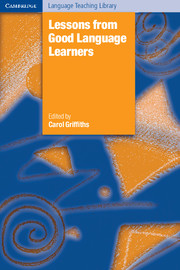Book contents
- Frontmatter
- Contents
- List of contributors
- Acknowledgements
- Editor's overview
- Prologue
- Reflections
- Part I Learner variables
- 1 Motivation and good language learners
- 2 Age and good language learners
- 3 Learning style and good laguage learners
- 4 Personality and good language learners
- 5 Gender and good language learners
- 6 Strategies and good language learners
- 7 Metacognition and good language learners
- 8 Autonomy and good language learners
- 9 Beliefs and good language learners
- 10 Culture and good language learners
- 11 Aptitude and good language learners
- Part II Learning variables
- The learners' landscape and journey: a summary
- Index
6 - Strategies and good language learners
Published online by Cambridge University Press: 11 August 2009
- Frontmatter
- Contents
- List of contributors
- Acknowledgements
- Editor's overview
- Prologue
- Reflections
- Part I Learner variables
- 1 Motivation and good language learners
- 2 Age and good language learners
- 3 Learning style and good laguage learners
- 4 Personality and good language learners
- 5 Gender and good language learners
- 6 Strategies and good language learners
- 7 Metacognition and good language learners
- 8 Autonomy and good language learners
- 9 Beliefs and good language learners
- 10 Culture and good language learners
- 11 Aptitude and good language learners
- Part II Learning variables
- The learners' landscape and journey: a summary
- Index
Summary
In the 30 years since Rubin's (1975) article in TESOL Quarterly brought “language learning strategies” to a wide audience, the concept of language learning strategy has been notoriously difficult to define. It has been described as “elusive” (Wenden, 1991, p. 7), “fuzzy” (Ellis,1994, p. 529) and “fluid” (Gu, 2005, p. 2). Rubin (1975, p. 43) defined language learning strategies as “the techniques or devices which a learner may use to acquire knowledge,” and she constructed a list of strategies typical of good language learners. Stern (1975) also published an article on the strategies used by good language learners, among which he included “a personal learning style” (p. 316). The confusion evident even at this early stagein language learning strategy research between basic concepts such as style and strategy has contributed to the difficulties with definition which remain to the present day.
Defining and classifying strategies
A number of studies continued to add to the growing body of knowledge (and controversy) regarding language learning strategies through the remainder of the 1970s and into the 1980s. Think aloud techniques were used by Hosenfeld (1976) to find out more about students' strategies, and another good language learner study was contributed by Naiman, Fröhlich, Stern, and Todesco (1978). The role of conscious language learning strategy choices was examined within a theoretical model of second language learning (Bialystok, 1978, 1981); language learning strategy use in relation to individual student differences was investigated by Wong Fillmore (1979); and the use of mnemonic strategies for the retention of vocabulary was looked at by Cohen and Aphek (1980).
- Type
- Chapter
- Information
- Lessons from Good Language Learners , pp. 83 - 98Publisher: Cambridge University PressPrint publication year: 2008
- 32
- Cited by



